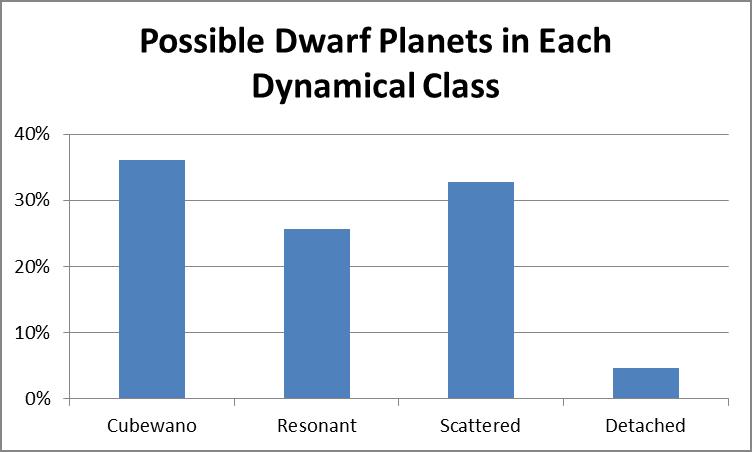The Pluto flyby is a once-in-a-lifetime event, so to get ready I’m writing a series on the Kuiper Belt. This time we’ll look at how solar system bodies are classified by the way they dance.
Orbital Resonance

When you pump your legs in resonance with the swing’s natural frequency, the energy of your leg motion is consistently transferred into the energy of the swinging. Image: Edd Prince via Wikimedia, CC BY 2.0
The planets’ orbits are affected by something called resonance.
When you were a child you learned how to swing on a swing set by pumping your legs with just the right timing to make it go. You were learning how to achieve resonance between your legs and the swing. Once you had that special timing figured out, the energy of your legs got transferred into the motion of the swing so the more times you pumped, the higher the swing went.
You probably tried messing with the resonance of your legs, too. You may have discovered that you can pump your legs twice as fast for every swinging motion and it still sorta works. That is a 2-to-1 resonance, denoted as 2:1. Other resonances could work, though they are not as efficient. You may have also noticed that changing the timing of the leg pump can slow the swing back down and make it stop. That’s because you are making the energy go in the opposite direction, from the swing back into your legs. And if you pump your legs at random times then it makes the swing go all wonky but it doesn’t slow down or speed up overall.
Planets going around the sun can behave similarly. Each time a faster planet passes a slower one, their gravities kick each other like legs pumping a swing. (This is how astronomers discovered Neptune. They could see something was giving little kicks to Uranus’ orbit.) As long as the planets are in orbits where the kicks happen at random times, then it’s like wonky pumping on a swing set. Those planets will wobble a bit but basically stay in their orbits. However, when planets are synchronized, then the kicks will happen at the same place each time around the sun, and one planet can start speeding up while the other slows down.
Check out the video that shows a simple experiment you can do at home to help your mom or dad understand resonances and get them ready to enjoy the Pluto flyby. (You can explain to them how it illustrates Pluto’s orbital resonance with Neptune. That will be discussed, below.)
Resonance in the Asteroid Belt
At a certain distance from the sun, an asteroid completes exactly three orbits for every one orbit of Jupiter (denoted as 3:1). The asteroid in that orbit gets regular kicks from Jupiter like legs pumping on a swing set. This causes the asteroid’s orbit to change year-by-year until it’s in a much different orbit. In addition to this 3:1 resonance, there is a 5:2 resonance, and 7:3, and others at various distances from the sun. This resonance effect has produced gaps in the asteroid belt. Wherever an asteroid would have been in resonance with Jupiter, Jupiter kicked it away. These are called the Kirkwood Gaps.
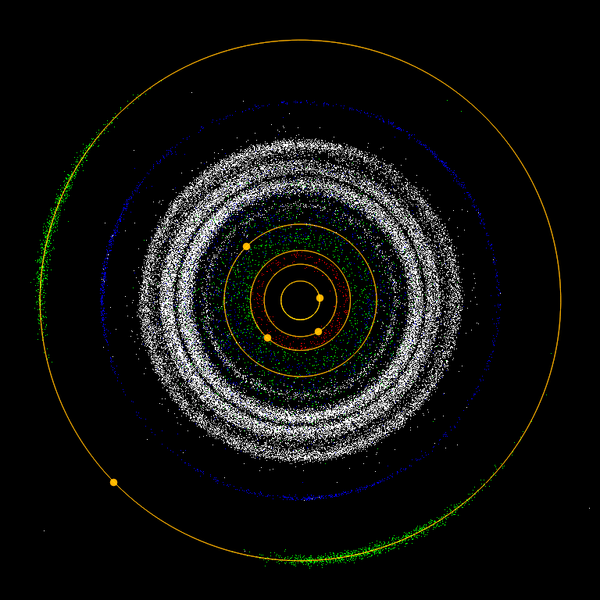
The Kirkwood Gaps can be seen in this representation of the main asteroid belt. The outermost orbit in this diagram is Jupiter. Credit: Wikimedia
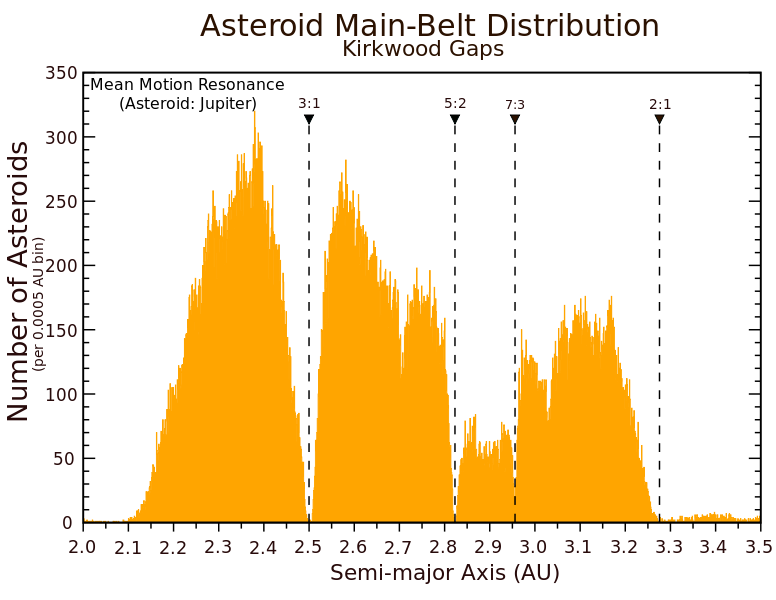
Number of asteroids at each distance from the sun. Distances that produce resonance with Jupiter are not populated with asteroids, because Jupiter’s synchronized pumping has already pushed them all away. Credit: Alan Chamberlin, JPL/Caltech via Wikimedia
Resonances can do more than empty an orbit, however. They can also fill an orbit. At the outer edge of the asteroid belt there is a class of asteroids called the Hildas. They have a 3:2 resonance with Jupiter, so they orbit the sun three times when Jupiter orbits just twice. Their orbits are elliptical so by swinging closer to and farther from the sun they pass Jupiter at a safe distance the swing back near Jupiter’s path again while Jupiter is elsewhere around the sun. Thus, they avoid strong kicks from Jupiter that would push them out of the resonance. They do, however, get little kicks from Jupiter, and the kicks actually tend to shepherd the Hildas back into these special orbits.
The following video is in a rotating reference frame. In other words, the “camera” looking down at the solar system is rotating along with Jupiter so it seems that Jupiter (the big dot on the left) is standing still. The Hildas are actually in elliptical orbits around the sun, but in this rotating reference frame they appear to move between three corners of a triangle. Studies have shown that Jupiter probably collected the Hildas by shepherding them into this 3:2 resonance as it migrated closer to the sun billions of years ago.
Resonance in the Kuiper Belt and Beyond
In the outer solar system beyond Neptune, the planetary bodies may been grouped into the following classes based on the type of orbit they have. These are called dynamical classes.
Relatively Stable Orbits
Classical Kuiper Belt Objects (Cubewanos)
The cubewanos are relatively stable because they keep a modest distance from Neptune and they aren’t in any resonance, so the little kicks from Neptune are randomized, like wonky kicking on a swing set. The kicks make them wobble, but it doesn’t add up to anything consistent. Nevertheless, they may be randomly nudged over time into more unstable orbits from which they will be scattered away. They are playfully called cubewanos because the first one discovered was numbered 1992 QB1, and the QB1 was given an “o” at the end to make it sound similar to plutino or twotino: “Q-B-One-oh.”
Quaoar and Makemake are two of the dwarf planets that are cubewanos. In fact, a recent list of known Kuiper Belt Objects shows 29 of the cubewanos are probably large enough to be dwarf planets and another 102 are possibly large enough to be dwarf planets. (We need better measurements to know for sure.) You might think that makes it a crowded place in the Kuiper Belt, but actually it is not. The distances are vast that far from the sun, and the area of the ecliptic plane per dwarf planet is more than 1000 times greater in the Kuiper Belt than the area per planet in the inner solar system. More than 1000 times! It is the inner solar system that is crowded. (In my opinion, these Kuiper Belt bodies actually have cleared their orbits and should be classified as planets. More on this, below.)
Resonant Bodies
Haumea is an example of a resonant body. It is in a 7:12 resonance with Neptune. Resonances can be any combination of small integers, like 2:3, or 3:5, or 4:7. We know of 27 resonant bodies that are probably large enough to be dwarf planets, and 66 more that are possibly large enough.
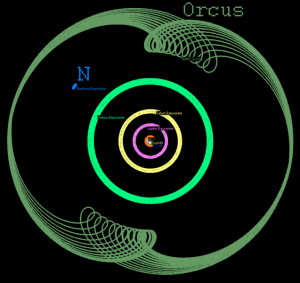
The orbital path of Orcus in a view that rotates to keep Neptune (N) stationary. Note how Orcus keeps a great distance from Neptune. The small orange circle near the center is the orbit of Mars, showing the tiny size of the inner solar system. Dancing around the giant planets simply cannot fit there. Credit: kheider via Wikimedia
Plutinos
This is a subclass of the resonant bodies. They include Pluto, the dominant member of the Kuiper Belt, hence the name. They are in a 2:3 resonance with Neptune, so every time Neptune goes around the sun three times, they go around twice. There are lots and lots of plutinos. Orcus and Ixion are two more examples. We know of 19 plutinos that are probably large enough to be dwarf planets, and 32 more that are possibly large enough.
Twotinos
This is another subclass of the resonant bodies. They are in a 1:2 resonance with Neptune, hence the name. They are considered the outer edge of the Kuiper Belt, meaning that they have an average distance from the sun that is larger than the other Kuiper Belt bodies. (But they are in elliptical orbits so they all move into and out of the main bulk of the Kuiper Belt; it’s an abstract edge.) Recent data show three known twotinos are probably large enough to be dwarf planets while 30 more are possibly large enough.
Tostitos
These bodies are a snack, not technically part of the Kuiper Belt, and they are not in any known planetary resonance except with the Earth. They may be eaten during the Pluto flyby. We have never found a Tostito large enough to be a dwarf planet. #NerdHumor
Detached Objects
These bodies are not considered part of the Kuiper Belt. They avoid Neptune’s gravitational bullying by staying far away from its territory. They might swing into the heart of the Kuiper Belt at their closest approach to the sun, but never close to the orbit of Neptune, and their farthest distance from the sun is way, way out there. Thus they do seem rather detached, but many planetary scientists are still attached to them. Seven known detached objects including Sedna are probably large enough to be dwarf planets, and another 10 are possibly large enough.
Unstable Orbits
Scattered Disc Objects
These bodies are not considered part of the Kuiper Belt. They are in unstable orbits and they are right now in the process of being pushed around by Neptune. Their orbits may pass through the Kuiper Belt, but they are typically very tilted and elliptic. Twenty two scattered disc objects are probably large enough to be dwarf planets, including Eris and Salacia. Another 97 are possibly large enough.
Where are the Kirkwood Gaps of the Kuiper Belt?
When you look at the distribution of main belt asteroids versus their distance from the sun (above), you see very obvious gaps wherever there is a resonance. The resonances actively push the asteroids away. But when you look at the known Kuiper Belt objects versus their distance from the sun (below), you don’t see these gaps. Instead, you see clustering of bodies at the resonances. Why the difference?
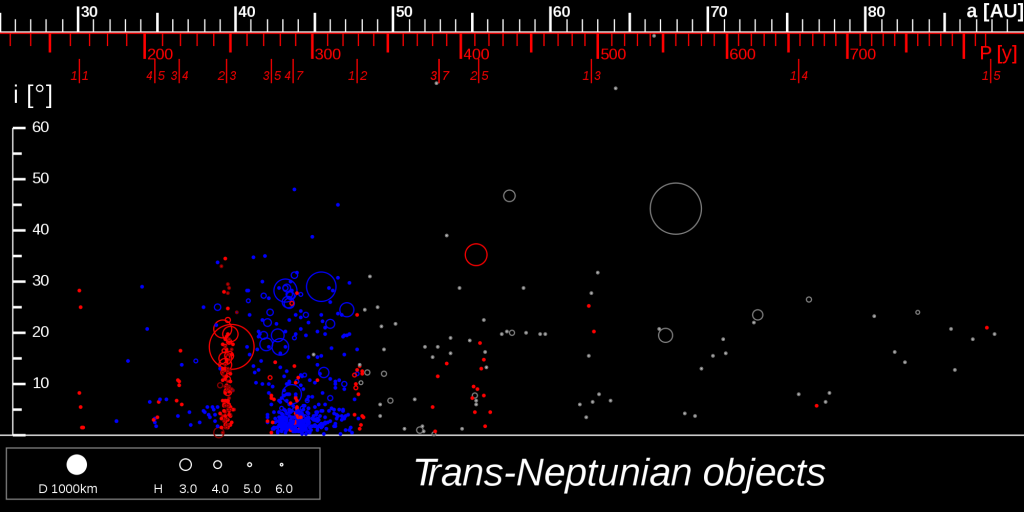
Click for larger version. Each circle represents a known body beyond Neptune. The location of each circle in the horizontal axis is the semi-major axis of the body, sort of like an average distance from the sun (measured in Astronomical Units, or AU). The vertical location tells the tilt of the body’s orbit relative to the solar system’s ecliptic plane. The size of each circle is an estimate of the size of the body. Resonances are annoted near the top of the figure. You can see that bodies tend to be clustered at some of the resonances. Dark red bodies are plutinos. Blue are cubewanos. More color coding and information is given at this link. Image source: Wikimedia
We think the difference is because of Saturn. Main belt asteroids have to contend with gravitational kicks from both Jupiter and Saturn, and it is hard enough to satisfy one bully at a time, nearly impossible to satisfy two. For the Hildas, they are close enough to Jupiter that it is able to keep shepherding them into the 3:2 resonance despite Saturn’s disturbances. Bodies in other, weaker resonances, however, were not so lucky. When Saturn bumps them, their timing with Jupiter is not quite right so Jupiter kicks them out of the orbit entirely. In the Kuiper Belt, bodies only need to satisfy Neptune’s bullying. Uranus is so far away — the distances in that part of the solar system are so much greater — that it doesn’t have enough effect.
Another Reason Why Pluto is a Planet
Here are the statistics on the dwarf planets discovered so far in the outer parts of the solar system.
Why don’t we see these different kinds of orbits among the planets in the inner solar system?
The cubewanos are similar to the major planets of the inner solar system, so this is the one class we do see here. This type of body is in relatively stable orbits because they are far enough from the nearest giant planet and also not in resonance with it, so the weak gravitational kicks are random and average out. There are so many more of these in the outer solar system than the inner because they have more room to orbit without disturbing one another.
The resonant bodies of the Kuiper Belt are relatively stable because they are in highly elliptic orbits that take them far from Neptune every time the giant planet passes by, thus avoiding big kicks. This type of motion simply doesn’t fit as a stable orbit in the small space of the inner solar system. We expect that Mercury will eventually go into a secular resonance with Jupiter (a different kind of resonance than discussed here), and this will push it to a more elliptic orbit. There’s no room for it to stay like that in the inner solar system. It will collide with one of the other planets and be destroyed, or it might thread the needle and escape to the outer solar system, but then it would no longer be defined as a planet according to the IAU’s current definition.
The detached objects are stable simply because they are so far away. Needless to say, that cannot exist in the inner solar system since the space is too small.
The scattered disc objects are in the process of being moved by Neptune. They can exist in their highly elliptical orbits for a long time in the vast space of the Kuiper Belt. The similar objects that exist in the inner and middle solar system (asteroids, comets, and centaurs) cannot exist as long before colliding with a planet, so they must be continually replaced from the Main Asteroid Belt, the Kuiper Belt, and the Oort Cloud. These transient bodies are mostly small, simply because small bodies are so much more common than large ones. On the rare occasion that a larger body begins scattering in the inner solar system (like Mercury may one day, or like Theia may have done in the past) the chances are it won’t survive long before it strikes a planet. So it’s not surprising we see no planet-sized bodies in the inner solar system belonging to this dynamical class. Again, the space is just too small.
Unfortunately, we based the definition of a planet on our experience in the inner solar system, where planetary dynamics are not diverse. These more diverse dynamical classes are capable of coexisting in the the vast space of the Kuiper Belt, and it was this fact that made the IAU declare the KBOs are not true planets. When we say the inner solar system planets have “cleared their orbits”, what we really mean is that there isn’t enough room inside the inner solar system for these other dynamical classes to exist. They only exist where there is room for them, and that’s by definition. It’s not a property of the Earth or Mars that its orbit is clear. It’s merely the fact that dynamical diversity doesn’t fit within their distances from the sun. It’s not a deficiency of Pluto that it’s orbit hasn’t been “cleared”. It’s just that the outer solar system is much bigger than the inner, so it supports a more diverse phenomenology.
So in the final analysis, the IAU definition of a planet is tantamount to this:
To be a planet, a body must: (1) orbit the sun, (2) be gravitationally round, and (3) exist in a location where interesting dynamical classes cannot fit.
There’s no such thing as clearing an orbit where the interesting dynamical classes can fit, because if they can fit, then they exist. And they will continue to exist until the sun burns out.
I don’t find this a very satisfying definition of a planet, one that determines a priori that the outermost zone of the solar system shall have no planets in it, simply because it can have so many. I would rather let nature show us which of our words describe it best. Planets means wanderers in the original Greek, referring to the lights in the sky that wandered through regular paths against the background of stars. And wander they do in the Kuiper Belt! Their wandering is so interwoven it could even be called a dance. Near the sun it is too crowded for the wanderers to dance, so they circle round and round like donkeys at a grist mill, till finally Jupiter pushes them from their tracks and they die in the escape or survive to the dance beyond. Out there, bodies rarely collide, and they move with a collective complexity that would make choreographers proud. To my thinking that makes them consummate wanderers, all the more planet-like, not less. It makes their wandering more beautiful, more interesting, and more surprising, like everything in nature when we finally see it for the first time.
If you found this interesting, please share it! And I would love to discuss this with you so please comment below.
